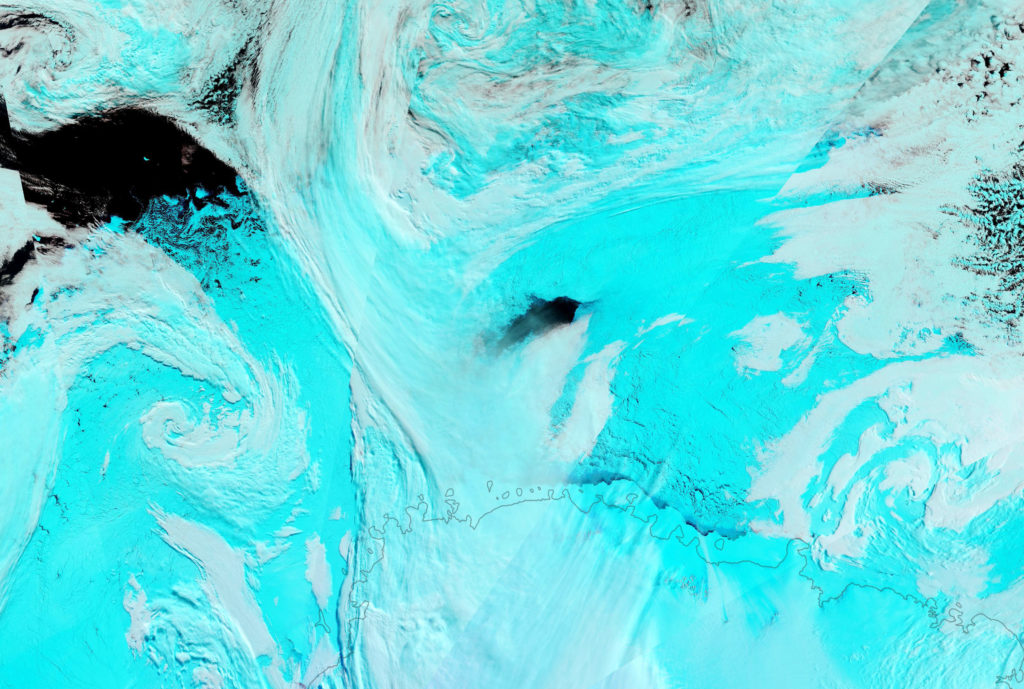 [1]
[1]The Moderate Resolution Imaging Spectroradiometer (MODIS) on NASA’s Terra satellite acquired this false-color image of the Maud Rise or Weddell polynya in the eastern Weddell Sea on September 25, 2017. Areas of ice are in blue, clouds are in white. [Image credit: NASA Earth Observatory].
Convection, and the mixing for which it is responsible, is a ubiquitous feature of the mixed-layer at the surface of the ocean, but such convection differs distinctly from open-ocean deep convection where the surface forcing and ambient stability combine in such a way that the thermocline is locally erased enabling mixing to occur to uncommonly great depths.
Perhaps surprisingly there are only a handful of rather small sites where open-ocean deep convection is known to occur. The principal locations for offshore deep water formation of this kind are in polar regions, in the southern hemisphere in the Weddell and Ross Seas off the Antarctic coast (where Antarctic Bottom Water is formed) and in the northern hemisphere in the Labrador and Greenland Seas (where North Atlantic Deep Water is formed.)
Certainly the most famous open-ocean case is the Weddell polynya which occurs in the Lazarev Sea over Maud Rise a Southern Ocean seamount at 66° S, 3° E. First spotted in September 1973, the polynya (then observed to be the size of New Zealand), re-occurred each winter between 1974 and 1976. Recently, after an absence of four decades, the polynya, though smaller, returned, recurring in the winters of 2016 and 2017.
While such polynyas occur only rarely in the observational record they turn out to be a near-permanent feature of many climate and ocean simulations; an observation that piqued the attention of a team at British Antarctic Survey prompting them to ask the question “What impact might excess deep-convection have on basal melting of neighboring ice shelves?”

Kaitlin Naughten is an ocean modeler specializing in ice shelf, ocean, and sea ice interactions around Antarctica. Recent areas of interest include water mass characteristics in ice shelf cavities, circulation beneath the Filchner-Ronne Ice Shelf, and ice-sheet/ocean coupling. She started using MITgcm in April 2018 when she joined She BAS as part of the FISS (Filchner Ice Shelf System) project. As well as ocean modeling she is passionate about science communication. Check out her blog post about this work [3] at http://climatesight.org. [4]
Using MITgcm, Kaitlin Naughten [5], together with co-authors Adrian Jenkins [6], Paul R. Holland [7], Ruth I. Mugford [8], Keith W. Nicholls [9], and David R. Munday [10] performed regional ocean simulations of the Weddell Gyre and Filchner-Ronne Ice Shelf (FRIS) to assess the degree to which the Weddell polynya affects the nearby FRIS cavity (the body of water the shelf floats on) by imposing deep convection with varying area, location, and duration. Their work is published in the Journal of Climate [11].
Using a regional domain covering the Weddell Gyre and the continental shelves of the Weddell Sea, bounded by the Antarctic Peninsula to the west, the FRIS grounding line to the south, and open eastern and northern boundaries at 308E and 618S, respectively, the team ran simulations including ocean, sea ice, and ice shelf components.
Horizontal grid spacing ranged from 3 km in the south to 13 km in the north. In the vertical, the team opted for 120 levels with varying resolution: 10 m near the surface, 25 m for all depths covered by the FRIS cavity, and 100–350 m in the deep ocean. Their configuration used the z* coordinate system and included partial cells to allow a more accurate representation of topography.
“In our simulations, the presence of the idealized Weddell polynyas consistently caused an increase in Warm Deep Water transport onto the continental shelf as a result of density changes above the shelf break leading to saltier, denser source waters for the FRIS cavity, a stronger circulation within the cavity, and increased ice shelf basal melting,” says Naughten.
“Weddell polynyas similar to those seen in observations had only a modest impact on FRIS melt rates and were within the range of simulated interannual variability,” she says. “However, polynyas that were larger or closer to the shelf break, such as those seen in many ocean models, were observed to trigger a stronger response. This suggests to us that ocean models with excessive Weddell Sea convection may not provide suitable boundary conditions for regional models of the Antarctic continental shelf and ice shelf cavities.”
To find out more about this work contact Kaitlin. [12]
This Month’s Featured Publication
- Kaitlin A. Naughten, Adrian Jenkins, Paul R. Holland, Ruth I. Mugford, Keith W. Nicholls, and David R. Munday (2019), Modelling the influence of the Weddell Polynya on the Filchner-Ronne Ice Shelf cavity [11], Journal of Climate, doi: 10.1175/JCLI-D-19-0203.1
Other New Publications this Month
E. Álvarez, S. Thoms, A. Bracher, Y. Liu, C. Völker (2019), Modeling Photoprotection at Global Scale: the Relative Role of Non‐Photosynthetic Pigments, Physiological State and Species Composition [13], Global Biogeochemical Cycles, doi: 10.1029/2018GB006101
R. L. Beadling, J. L. Russell, R. J. Stouffer, P. J. Goodman, and M. Mazloff (2019), Assessing the quality of Southern Ocean circulation in CMIP5 AOGCM and Earth System Model simulations [14], Journal of Climate, doi: 10.1175/JCLI-D-19-0263.1
Jacinta M. K. Clay (2019), Interaction of Sea Surface Ice Floes in Fluid Dynamical Eddy Simulations [15], Bachelor of Science Dissertation, Department of Earth, Environmental, and Planetary Sciences, Brown University [pdf] http://www.geo.brown.edu/research/Fox-Kemper/pubs/pdfs/ClayThesis.pdf
Samuel J. Cook, Poul Christoffersen, Joe Todd, Donald Slater, Nolwenn Chauché (2019), Coupled modelling of subglacial hydrology and calving-front melting at Store Glacier, West Greenland [16], The Cryosphere, doi: 10.5194/tc-2019-104
Tim DeVries, Corinne Le Quéré, Oliver Andrews, Sarah Berthet, Judith Hauck, Tatiana Ilyina, Peter Landschützer, Andrew Lenton, Ivan D. Lima, Michael Nowicki, Jörg Schwinger, and Roland Séférian (2019), Decadal trends in the ocean carbon sink [17], PNAS, doi: 10.1073/pnas.1900371116
Pedro Duarte, Jan Marcin Weslawski, Haakon Hop (2019), Outline of an Arctic fjord Ecosystem Model for Kongsfjorden-Krossfjorden, Svalbard, In: Hop H., Wiencke C. (eds) The Ecosystem of Kongsfjorden, Svalbard [18]. Advances in Polar Ecology, vol 2. Springer, Cham, doi: 10.1007/978-3-319-46425-1_12
Rodolfo Espina-Valdés, Eduardo Álvarez Álvarez, Julio García-Maribona, Antonio José Gutiérrez Trashorras, Juan M. González-Caballín (2019), Tidal current energy potential assessment in the Avilés Port using a three-dimensional CFD method [19], Clean Techn Environ Policy, doi: 10.1007/s10098-019-01711-2
Hazel, Julia Eileen (2019), Exploring the Wind-Driven Near-Antarctic Circulation [20], UCLA Electronic Theses and Dissertations https://escholarship.org/uc/item/1gs7z5zm
Ch. Helling, N. Iro, L. Corrales, D. Samra, K. Ohno, M.K. Alam, M. Steinrueck, B. Lew, K. Molaverdikhani, R.J MacDonald, O. Herbort, P. Woitke, and V. Parmentier (2019), Understanding the atmospheric properties and chemical composition of the ultra-hot Jupiter HAT-P-7b [21], arXiv:1906.08127 [astro-ph.EP]
Samuel J. Levang (2019), The Response of Ocean Salinity Patterns to Climate Change: Implications for Circulation [22], Doctoral Dissertation, Massachusetts Institute of Technology/ Woods Hole Oceanographic Institution [pdf] https://darchive.mblwhoilibrary.org/bitstream/handle/1912/24175/Levang_Thesis.pdf
Jianjun Liang, Xiao-Ming Li, Jin Sha, Tong Jia, and Yongzheng Ren (2019), The Lifecycle of Nonlinear Internal Waves in the Northwestern South China Sea, [23] Journal of Physical Oceanography, doi: 10.1175/JPO-D-18-0231.1
Bo Mao, Li-Guo Han, Qiang Feng, Yu-Chen Yin (2019), Subsurface velocity inversion from deep learning-based data assimilation [24], Journal of Applied Geophysics, doi: 10.1016/j.jappgeo.2019.04.002
Julien Michel, Marie Laugié, Alexandre Pohl, Cyprien Lanteaume, Jean-Pierre Masse, Yannick Donnadieu, Jean Borgomano (2019), Marine carbonate factories: a global model of carbonate platform distribution [25], International Journal of Earth Sciences, doi: 10.1007/s00531-019-01742-6
Kaitlin A. Naughten, Adrian Jenkins, Paul R. Holland, Ruth I. Mugford, Keith W. Nicholls, and David R. Munday (2019), Modelling the influence of the Weddell Polynya on the Filchner-Ronne Ice Shelf cavity [11], Journal of Climate, doi: 10.1175/JCLI-D-19-0203.1
Pefanis, V. , Losa, S. N. , Soppa, M. A. , Losch, M. , Dutkiewicz, S. , Janout, M. , Rozanov, V. V. and Bracher, A. (2019): Assessing bio-physical feedbacks in the Arctic Ocean under Arctic amplification [26] , EGU General Assembly 2019, Vienna, Austria, 7 April 2019 – 12 April 2019, https://epic.awi.de/id/eprint/49739/
Naila F. Raboudi, Boujemaa Ait-El-Fquih, Clint Dawson, and Ibrahim Hoteit (2019), Combining Hybrid and One-Step-Ahead Smoothing for Efficient Short-Range Storm Surge Forecasting with an Ensemble Kalman Filter [27], Monthly Weather Review, doi: 10.1175/MWR-D-18-0410.1
Casey P. Saenger, Michael N. Evans (2019), Calibration and validation of environmental controls on planktic foraminifera Mg/Ca using global core‐top data [28], Paleoceanography and Paleoclimatology, doi: 10.1029/2018PA003507
Janet Sprintall et al (2019), Detecting Change in the Indonesian Seas [29], Frontiers in Marine Science, doi: 10.3389/fmars.2019.00257
Andrew L. Stewart, Andreas Klocker, Dimitris Menemenlis (2019), Acceleration and overturning of the Antarctic Slope Current by winds, eddies, and tides [30], Journal of Physical Oceanography, doi: 10.1175/JPO-D-18-0221.1
Manuel Valera, Mary P. Thomas, Mariangel Garcia and Jose E. Castillo (2019), Parallel Implementation of a PETSc-Based Framework for the General Curvilinear Coastal Ocean Model [31], Journal of Marine Science and Engineering, doi: 10.3390/jmse7060185
Daosheng Wang, Haidong Pan, Guangzhen Jin, Xianqing Lv (2019), Seasonal variation of the main tidal constituents in the Bohai Bay [32], Ocean Sci. Discuss., doi: 10.5194/os-2019-43
Jieshuo Xie, Yinghui He, Shuqun Cai (2019), Bumpy topographic effects on the transbasin evolution of large‐amplitude internal solitary wave in the northern South China Sea [33], Journal of Geophysical Research – Oceans, doi: 10.1029/2018JC014837
Do you have news about research using MITgcm? We are looking for contributions to these pages. If you have an interesting MITgcm project (ocean, atmosphere, sea-ice, physics, biology or otherwise) that you want to tell people about, get in touch. To make a post, contact Helen [34]